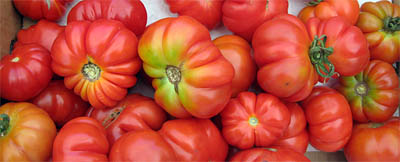Heirloom Tomato Seeds, Preserved

Tomatoes are extremely popular in backyard gardens, but unfortunately they are dominated by commercial F1 Hybrids which are bred for industry and economy – high density, thick skinned for mechanical harvesting, to name a few.
Heirloom tomatoes can be bred true from seed and are living legacies. The seeds from F1 Hybrids for example, cannot be bred effectively, if at all, from seed.
How to save Heirloom Tomato Seeds
You can use the simple method of squeezing out the seeds and air-drying them. This often works well enough. However there is a better way, using Fermentation.
Tomato Seed Fermentation
The fermentation process destroys the gel sac surrounding the seed (including growth inhibitors and any diseases). This is the process that happens naturally in nature when a tomato drops from the vine and rots on the ground.
Choose a container that will fill about half-way (not terribly critical though) with the pulp/seed mixture. For example, a pint size canning jar filled half-way will hold several tomatoes worth of pulp and seeds.
It is best to use one of the healthiest and largest tomatoes of the variety. Using just one variety (to keep track), cut the tomato, and squeeze out the juice, seeds, and pulp into a container. Work at getting as many seeds out of the tomato that you can.
For four days, keep the uncovered container (or with cheese-cloth on top to keep critters out) in a room temperature or slightly warm environment. Several times a day, stir the pulp mixture that floats to the top so that it mixes with the juice. The goop will smell a bit after awhile and will grow mold – not to worry – just keep it away from your daily traffic ;)
After four days, fill up the rest of the container with water and stir it. Pour out the pulp stuff while leaving the seeds which should be at the bottom of the container. Add water and repeat the process several times while trying to get as much pulp mixture out of the solution while leaving the seeds at the bottom.
Dump the seeds into a fine strainer sieve, and rinse with water while mushing what’s left of the pulp through the mesh.
Dump the seeds on to a paper plate by snapping the strainer up-side-down to the plate.
Spread the seeds around and let them dry for several weeks at room temperature.
Put the seeds in an airtight container and store them in a dark, cool, dry place. Keeping the air-tight container (Tupperware or Ziploc bag) inside of a brown paper bag does the trick too. Refrigeration will extend the life for many years. Be sure the storage container is air-tight though because humidity will cause degradation.
If you enjoyed this, or topics of preparedness or current events risk awareness, consider our survival blog RSS feed, new posts by E-mail, or bookmark us at Modern Survival Blog
